Plus Two Botany Chapter Wise Questions and Answers Chapter 2 Sexual Reproduction in Flowering Plants is part of Plus Two Botany Chapter Wise Questions and Answers Kerala. Here we have given Plus Two Botany Chapter Wise Questions and Answers Chapter 2 Sexual Reproduction in Flowering Plants.
| Board | SCERT, Kerala |
| Text Book | NCERT Based |
| Class | Plus Two |
| Subject | Botany Chapter wise Questions |
| Chapter | Chapter 2 |
| Chapter Name | Sexual Reproduction in Flowering Plants |
| Number of Questions Solved | 93 |
| Category | Plus Two Kerala |
Kerala Plus Two Botany Chapter Wise Questions and Answers Chapter 2 Sexual Reproduction in Flowering Plants
Plus Two Botany Sexual Reproduction in Flowering Plants One Mark Questions and Answers
Question 1.
Types of pollination in Commelina is
(a) chasmogamy
(b) geitonogamy
(c) xenogamy
(d) cleistogamy
Answer:
(d) cleistogamy
Question 2.
When pollen is transferred from another of a flower to stigma of the another flower of the of the same plant, it is referred to as
(a) allogamy
(b) xenogamy
(c) geitonogamy
(d) autogamy
Answer:
(c) geitonogamy
Question 3.
For plant breeding purposes: Pollens are stored at -196°C. What is the purpose behind it?
Answer:
Stored pollens can be used as pollen banks in crop breeding programmes.
Question 4.
Pollen tube enters the embryo sac through
(a) Integument
(b) Micropyle
(c) Calaza
(d) Funicle
Answer:
(b) Micropyle
Question 5.
In flowering plants, fertilization occur in
(a) Ovary
(b) Embryo sac
(c) Nucellus
(d) Ovule
Answer:
(b) Embryo sac
Question 6.
The source of food for developing embryo is
(a) Nucellus
(b) Ovule
(c) Endosperm
(d) Anther
Answer:
(c) Endosperm
Question 7.
Out of megaspre tetrad, the functional megaspore is
(a) Any megaspore
(b) Middle megaspore
(c) Micropylar megaspore
(d) Chalazal megaspre
Answer:
(d) Chalazal megaspre
Question 8.
How many megaspore mothe cell are produced in a nuclellus
(a) 3
(b) 1
(c) 2
(d) 4
Answer:
(b) 1
Question 9.
During the development of monosporic development of embryo sac, the nucleus of the functional megaspore divides
(a) Two times
(b) Three times
(c) Onetime
(d) Repeatedly
Answer:
(b) Three times
Question 10.
Cross pollination has an advantage of
(a) Mutation
(b) polyploidy formation
(c) Genetic recombination
(d) Crossing over
Answer:
(c) Genetic recombination
Question 11.
Unisexual flowers prevent
(a) Pollination
(b) Breeding
(c) Self-pollination
(d) Cross fertilization
Answer:
(c) Self-pollination
Question 12.
The function of the filiform apparatus is
(a) To nourish the pollen grain
(b) To guide the entry of pollen tube
(c) To develop pollen tube
(d) To carry pollen tube through style
Answer:
(b) To guide the entry of pollen tube
Question 13.
Find the odd one. Hilum, Funicle, Intine, Integuments
Answer:
Intine
Question 14.
Choose the correctly matched pair.
(a) Coleorrhiza – Hollow foliar structure
(b) Perisperm- Remanents of nucellus
(c) Proembryo – mature embryo
Answer:
(b) Perisperm – Remanents of nucellus
Question 15.
Choose the correct answer. The layer of microsporangium that nourishes the developing pollen grains is
(a) Endothecium
(b) Tapetum
(c) Middle layer
(d) Epidermis
Answer:
(b) Tapetum
Question 16.
A typical angiosperm embryo sac at maturity is.
(a) 7 nucleate 8 celled
(b) 8 nucleate 8 celled
(c) 7 nucleate 7 celled
(d) 8 nucleate 7 celled
Answer:
(d) 8 nucleate 7 celled
Question 17.
The process of formation of fruits without fertilization is called.
(a) Parthenogenesis
(b) Parthenocarpy
(c) Apomixis
(d) Autogamy
Answer:
(b) Parthenocarpy
Question 18.
Identify the wrong statements regarding post – fertilization development.
(a) The ovary wall develops into pericarp
(b) The outer integument of ovule develops into tegmen
(c) The fusion nucleus (triple nucleus) develops into endosperm
(d) The ovule develops into seed
Answer:
(b) The outer integument of ovule develops into tegmen
Question 19.
Dicot emdryo consists of
(a) radicle and plumule
(b) radicle;plumule, cotyledons and sometimes endosperm
(c) radicle and plumule, cotyledons and tegmen
(d) radicle andplumule, cotyledons tegmentesta
Answer:
(b) radicle,plumule, cotyledons and sometimes endosperm
Question 20.
These process are necessary for the complete development of male gametophyte from pollen mother cell
(a) one meiotic and two mitotic divisions
(b) one meiotic cell division and one meiotic cell division
(c) two meiotic cell division and one mitotic cell division
(d) two meiotic cell division
Answer:
(a) one meiotic and two mitotic divisions
Question 21.
A bilobeddithecus anther has 100 microspore mother cells per micro sporangium. How many male gametophytes this anther can produce?
Answer:
400 male gametophytes
Question 22.
An anther with malfunctioning tapetum often failsto produce viable male gametophytes. Give one reason.
Answer:
Tapetum nourishes developing pollen grains
Plus Two Botany Sexual Reproduction in Flowering Plants Two Mark Questions and Answers
Question 1.
Pollen grains are well preserved as fossil for many years due to some characteristics
- Name the chemical substance present in pollen wall promote such preservation
- Give reasons.
Answer:
- sporopollenin
- It is the most resistant organic material and can withstand high temperatures, strong acids, and alkali. No enzymes can degrade sporopollenin.
Question 2.
One time fertilization is the characteristic feature of majority of plants but angiosperm show two times of fertilization
- Two fusion occurs are different. Name it and write down the number of nuclei involved in such process
- Name the products and ploidy.
Answer:
- Syngamy. Two nuclei Triple fusion, three nuclei
- Zygote (2n), PEN (3n)
Question 3.
Commelina, viola, and oxalis that carries both chasmogamous and Cliestogamy flowers.
- Find out the main differences between them.
- Give the significance of Cliestogamy.
Answer:
1. Chasmogamous flowers with exposed anthers and stigma. Cleistogamous flowers do not open at all.
2. significance of Cliestogamy:
- It ensures self pollination.
- Purity of characters is maintained.
Question 4.
- Geitonogamy is a functional cross-pollination but not genetically. Justify?
- In Papaya, Autogamy and Geitonogamy do not occur. Give reason.
Answer:
1. Geitonogamy is functionally cross-pollination because transfer pollen takesplace between different flowers of same plant that bear same genetic makeup.
2. Papaya is dioecios plants, because, the male and female flowers are present on different plants, which prevent autogamy and geitonogamy.
Question 5.
Wind pollination is common in grasses and water pollination in vallisneria. Give the features of these plants to facilitate pollination.
Answer:
1. Grasses
- Pollen grains are light weight and non-sticky
- Stigama is feathery.
2. Vallisneria
- Flowers do not produce nector and fragrance.
- Female flowers reach the surface of water by long stalk.
Question 6.
In most plants continuous self-pollination leads to inbreeding depression while in others certain devices help to discourage self pollination. Give any four devices.
Answer:
- Pollen release and stigma receptivity are not at the same time.
- Another and stigma are placed at different positions.
- Self-incompatibility.
- Production of unisexual flowers.
Question 7.
The micropyle remains as a small pore in the seed coat. What is its role?
Answer:
Micropyle facilitates the entry of oxygen and water into the seed during germination.
Question 8.
Draw the diagram of a typical dicot embryo and label the parts like plumule, cotyledons, radicle, and root cap.
Answer:
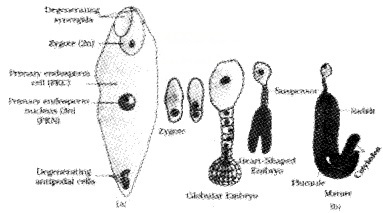
Question 9.
Observe the developmental stages given below and answer the following.
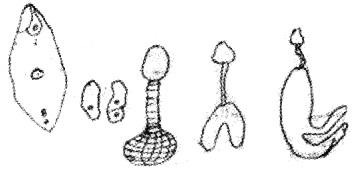
- Name the process.
- Label the stages A, B, C & D
Answer:
- Embryogenesis (Formation of embryo)
- A-proembryo B-globular stage C-heart shaped stage D-mature stage
Question 10.
Apomictic seeds are important in agriculture. Do you agree? Give reason.
Answer:
Yes. These seeds are formed without fertilisation hence there is no genetic variation .This feature is helpful to preserve the desirable characters for many years.
Question 11.
Give the technical terms for the following
- Produce seeds without fertilization
- Persistent nucellus
Answer:
- Parthenocarpy
- Perisperm
Question 12.
Emasculation may not be necessary. Yet bagging is necessary. Justify giving the condition when such a thing can happen.
Answer:
When the flower chosen is unisexual (female), there is no need for emasculation. Yet bagging is necessary to prevent contamination of the stigma with unwanted pollen grains.
Question 13.
Banana is a true fruit and also a parthenocarpic fruit. Justify.
Answer:
Since banana fruit is formed from ovary it is true fruit. It is parthenocarpic because the ovary develops into fruit without fertilization.
Question 14.
Arrange the following terms in the correct development sequence: Pollen grain, sporogenous tissue, microspore tetrad, pollen mother cell
Answer:
Sporogenous tissue → Pollen mother cell → Microspore tetrad → Pollen grain.
Question 15.
Some peoples live in area are subjected to allergic disease due to pollen grains.
- Give an example for plants that produce pollen of above type?
- Give an example for two disease?
Answer:
- Parthenium (Carrot grass)
- Asthma and Bronchitis
Question 16.
Typical angiosperm embryo sac is 7 celled and 8 nucleate. This condition occurs due to the development of megaspore mother cell
- How many meiotic and mitotic division takes place
- What you mean by monosporic development?
Answer:
- Single meiotic division and 3 mitotic division.
- Single functional megaspore develops into mature embryo sac.
Question 17.
Pollen allergy that causes chronic respiratory disorders in men like asthma and bronchitis. Name the causative plant.
Answer:
Parthenium or carrot grass
Question 18.
Some pollen grains cannot germinate on stigmatic surface due to the loss of viability
- Name the factors influence the viability of pollen
- How do the pollen grains can keep up for many years
Answer:
- Temperature and humidity
- Pollen grains are kept in Pollen Bank at-196 degree Celsius in liquid nitrogen.
Question 19.
Pollen tube growth occurs through the stylar region and reach micropyie of ovule. Name the special cellular thickening that guides Pollen tube
Answer:
Filiform apparatus
Question 20.
Pollengrains of many plants are found to be allergic.
- Do they have any benefits other than the involvement in reproduction? Explain
- Give examples.
Answer:
1. Pollen grains are rich in nutrients. In recent years pollen tablets are used as food supplements. It is used in western countries in the form of syrup and tablets. Pollen consumption has been claimed to increase the performance of athletes and race horses.
2. Parthenium, acasia
Question 21.
Zygote development leads to the formation of embryo.
- Name the nutritive tissue that helps in the development of embryo
- What will be the ploidy of such a tissue
Answer:
- endosperm
- endosperm is triploid
Question 22.
Suppose you are given four flowers namely maize, vallisneria, sunflower, and zostera.
- State the mode of pollination in each flower.
- Differentiate between cleistogamous and chasmogamous flowers.
Answer:
1. Maize-wind pollination
Vallisnaria-water pollination Sunflower – insect pollination
2. Cliestogamous – closed flower
Chamogamous – opened flower
Question 23.
A close relationship exist between a species of moth and the plant Yucca, where both species moth and Yucca cannot complete their life cycles without each other. Justify it.
Answer:
The moth deposits its eggs in the locule of the ovary of the Yucca flower. Flower in turn gets cross pollinated by the moth. The larvae of the moth come out of the eggs as the seeds starts developing.
Question 24.
Coconut and groundnut are oil yielding crops, point out the difference in the structure of seed.
Answer:
Coconut is an endospermous seed. Reserve food materials like fat, oil, etc. are stored in endosperm, in which the prominent part is endosperm and small sized embryo is situated at one end of the endosperm.
Question 25.
Seeds are formed in angiosperms when male and female gametes get fused. But in some plants seeds are produced without the fusion of gametes.
- Name the process,
- Comment.
Answer:
1. Apomixis
2. Apomixis is a form of asexual reproduction which mimics sexual reproduction. Seeds are produced from a diploid egg cell without reduction division and fertilization. Nucellar tissue surrounding the embryosac develops into an embryo.
Question 26.
In market, seedless grapes are high priced than seeded grapes. Give the method used to develop the former.
Answer:
The seedless grapes are developed through induced parthenocarpy.
Question 27.
Plant A with combined desired characters that are inherited from parents. Plant B with desired characters are pure. Find out the types of pollination leads to accurance of characters in both A & B.
Answer:
In plant A, cross-pollination leads to the occurance of mixing of characters while in Plant B self pollination and self-fertilisation results the pure character.
Question 28.
If the diploid chromosome number of a plant is 24. Find out the number of chromosomes in synergid, Antipodal, and endosperm.
Answer:
Here 2n=24, n=12 so the number of chromosomes in synergids and antipodals are 12 each. But endosperm is triploid, chromosome number is 36.
Question 29.
Pollination is aided by biotic and abiotic agents. Identify the type of pollination in Vallisneria, coconut, and grass.
Answer:
- Vallisneria -water pollination
- Coconut and grass-wind pollination.
Question 30.
Give the technical terms for the following
- Produce seeds without fertilization
- Persistent nucellus
- Cotyledons of grass family
- Protective sheath of radical.
Answer:
- Parthenocarpy
- Perisperm
- Scutellum
- Coleorhizae
Question 31.
Why do you think the zygote is dormant for some time in a fertilized ovule?
Answer:
This is because the embryo develops only after the formation of endosperm. So the zygote wait for endosperm formation which supplies food material for developing embryo.
Question 32.
In some plants self-pollination is prevented by genetic mechanism of either pollen or pistil
- Name the process
- Why does such process not lead to seed formation?
Answer:
- Self incompatibility
- It is because of interaction between the chemicals of the pollen and those of stigma (Pollen-pistil interaction)
Question 33.
If one can induce parthenicarpy through the application of growth substances, which fruits would you select to induce parthenocarpy and why?
Answer:
Watermelon, Orange and lemon because in these fruits the seeds are scattered within their edible parts and if seed are removed they become more valuable.
Question 34.
Embryosac or female gametophyte of angiospemn is 7 celled and 8 nucleate How many haploid cells are present in micropylar and chalazal part of female gametophyte of a flowering plant? Name them.
Answer:
Chalazal-Antipodals3, micropylar- Synergids 2, Egg cell 1.
Question 35.
If you squeeze seed of orange you might observe many embryos of different sizes? How is it possible?
Answer:
In orange, nucellar cells surrounding embryosac start dividing, protrude into embryosac and form many embryos.
Question 36.
If the chromosome number of plant species is 16. What would be the chromosome number and ploidy level of
- microspore mother cell
- endosperm cells
Answer:
- Microspore mother cell 16
- Endosperm cell 24
Question 37.
Observe the flow chart given below. Fill in the blank 1 and 2. Write the relevance of the process indicated as 1.

Answer:
- Bagging
- Artificial pollination In bagging the entry of unwanted pollen to stigmatic surface is prevented
Question 38.
Apple and mango are fruits. But they are formed in different ways. How are they formed?
Answer:
Apple is called a false fruit because the thalamus develops into fruit. Here ovary is not involved. Mango is a fruit because it is formed from ovary
Question 39.
The synergids have special cellular thickening. Name the thickening and write its function.
Answer:
Filiform apparatus
It guides the pollen tube into the synergid
Question 40.
Analyse the table and fill in the blank.

Answer:
- Thalamus also contributes to fruit formation
- True fruit
- Parthenocarpy
- Banana
Question 41.
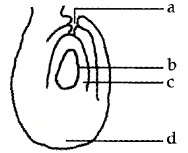
Answer:
- a – Micropyle
- b – Embryo sac
- c – Nucellus
- d – Chalaza
Question 42.
The embryo sac development in majority of flowering plants is monosporic development. Explain this type of embryo sac development.
Answer:
In this type a single megaspore mother cell of the nucellus differentiates in the ovule. Here Megaspore mother cell undergoes meiosis to form four megaspores, out of four, one megaspore becomes functional, while the other three degenerate. The functional megaspore develops into fully matured embryo sac.
Question 43.
Self-incompatibility and dioecious condition are two devices for discouraging self-pollination in plants. Explain the two.
Answer:
Self-incompatibility – In this, pollen fail to germinate on stigma/pistil of the same flower. This is due genetic mechanism of either male parent or female parent. Dioecious condition – It is the occurrence of Male and female flowers on different plants.
Question 44.
Peculiarities of certain parts of the ovule are given below. Name the parts.
- Protective envelops of the ovule
- Stalk of the ovule
- The layer of cells within the integuments
- Junction between ovule and funicle
Answer:
- Integuments
- Funicle
- Nucellus
- Hilum
Question 45.
Geitonogamy and xenogamy are two types of pollination. Differentiate between the two.
Answer:
1. Geitonogamy
It is the transfer of pollen grains from the anther to the stigma of another flower of the same plant.
2. Xenogamy
It is the transfer of pollen grains from anther to the stigma of a different plant.
Question 46.
The inner most wall layer of microsporangium is tapetum. It is multinucleate. Justify this statement.
Answer:
Out of four wall layers of anther, tapetum is the innermost layer that nourishes the developing pollen grains.
Question 47.
Peculiarities of two types of seeds are given below. Identify the two types of seeds and give example for each.
- Endosperm completely used by embryo.
- Endosperm not completely used by embryo.
Answer:
1. Non-albuminous/Ex-albuminous
Eg: Pea, Groundunt, etc.
2. Albuminous
Eg: Wheat, Maize, Barley, Castor, etc.
Question 48.
The embryo of monocotyledons and dicotyledons show difference in structure. Explain the structure of dicot embryo.
Answer:
A dicot embryo has an embryonal axis and two cotyledons. The portion of embryonal axis above the level of cotyledons is the epicotyl.it terminates in plumule. The Cylindrical portion below the level of cotyledons is hypocotyl, it terminates at its lower end in radicle.
Question 49.
Occurrence of more than one embryo in a seed is called polyembryony.
- Give two examples of polyembryony.
- How does polyembryony occur?
Answer:
- Citrus and mango
- Some of the nucellar cells surrounding the embryo sac is diploid that start dividing and develop into the embryos.
Question 50.
Mature pollen grain has a vegetative cell and a generative cell. Write the peculiarities of the two cells.
Answer:
Vegetative cell – It is the bigger cell possess abundant food reserve, Large irregularly shaped nucleus. Generative cell It is the small cell that floats in the cytoplasm of vegetative cell possess dense cytoplasm and a nucleus.
Question 51.
Endosperm develops from the primary endosperm nucleus. Explain the process of endosperm development.
Answer:
The PEN undergoes successive nuclear divisions that give rise to free nuclei later cell wall formation occurs and becomes cellular eg coconut.
Question 52.
Geitonogamy is similar to autogamy. Justify this statement.
Answer:
In geitonogamy pollen grains come from the same plant. Both Autogamy and geitonogamy are come under self pollination.
Question 53.
Apomixis is an asexual form of reproduction,that mimics sexual reproduction. Substantiate this statement.
Answer:
Apomixis is a kind of asexual reproduction in which seeds are produced without fertilization. By retaining the seed habit, it mimics to sexual reproduction.
Question 54.
Observe the relationship between the first two terms and fill in the blanks.
- Exine: Sporopollenin; Intine : …………..
- Pistils fused: Syncarpous; Pistils free: ………….
- Zygote : 2n ; Endosperm : …………..
Answer:
- Cellulose and pectin
- Apocarpous
- 3n
Plus Two Botany Sexual Reproduction in Flowering Plants Three Mark Questions and Answers
Question 1.
Pollen grains in angiosperms ace not motile. They have to be carried to the stigma by external agents.
- Name the process of transfer of pollen grains.
- Write the name of three such agents.
- Explain how it takes place in vallisnaria.
Answer:
1. Transfer of pollen grains from the anther to the stigma is called pollination.
2. Wind water and animals
3. In vallisneria the female flowers reach the surface of water by long stalk and the male flowers or pollen grains are released to the surface of water and are carried by water currents to the female flower and fertilization takes place.
Question 2.
Ramu while observing the C.S. of anther of Datura through a microscope, found fourwall layers.
- Name the layers.
- Write down its functions.
Answer:
1. layers:
- epidermis
- endothecium
- middle layer
- tapetum
2. The outer three layers perform protective function. Tapetum nourishes the developing pollen.
Question 3.
In flowering plants microspores are formed by meiosis and are haploid tetrads
- How will you show the formation of microspores and male gametophyte from microspore mother cells
- Write down the formation of embryosac and monosporic development?
Answer:
1. In the anther each cell of sporogenous tissue act as microspore mother cells (2n) which undergoes meiosis and forms four microspores (n) which are arranged in a cluster of four cells, ie.
microspore tetrad. When the anther matures the microspore dissociates from each other and develop into pollen grains. The pollen grains represents male gametophyte.
2. The nucellus of the ovule one cell is enlarged and act as megaspore mother cell (2n) which undergoes meiosis and results four megaspores (n) one of the megaspore is functional while the other three degenerates.
Only the functional megaspore develop into the embryo sac. Thus embryo sac formation from a single megaspore is called ‘monosporic’.
Question 4.
Fill up the blanks by observing the first pair.
1. Plumule: Shoot
………….: Root
2. Shoot apex: Coleoptile
Root apex: ………..
3. Ovary: Pericarp
Nucellus: ……………
4. Zygote: Embryo
…………: Endosperm
5. Syngamy: Zygote
……….: PEC
6. Ovule: Seed
…………: Seed coat
Answer:
- Radicle
- Coleorhiza
- Perisperm
- Primary Endosperm nucleus
- Triple fusion
- Integument
Question 5.
Diagrammatic representation of mature embryo sac is given.
- Identify the cells that are involved in fertilization
- Write the ploidy condition of that cells before and after fertilization.
- Point out the role of ‘x’ in the diagram.
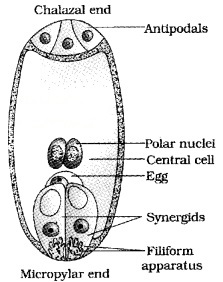
Answer:
1. Central cell (with two palar nuclei )and egg
2. Before fertilization – Central cell – 2n/ n+n
After fertilization – Central cell – 3n
Before fertilization – egg – n
After fertilization – egg. 2n.
3. Filiform apparatus – guides the pollen tubes into the synergids at the time of pollen germination prior to fertilization.
Question 6.
Double fertilization is the characteristic feature of angiosperms.
- What does it mean?
- Name the products and process.
Answer:1. It is the fertilization takes place two times.
2.
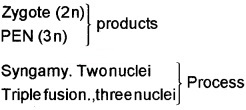
Question 7.
Haploidy, diploidy, and tripoloidy are the ploidy level of angiosperm plant parts from a seed is given below.
1. Find out the chromosome status of each part.
- Integuments outer, inner
- Nucellus
- Secondary nucleus
- Zygote
2. How will you give explanation to reduction of chromosome number from diploid to haploid?
Answer:
1. chromosome status of each part:
- Integuments outer and inner-2n(diploid)
- Nucellus-2n (diploid)
- Secondary nucleus-3n (triploid)
- Zygote-2n (diploid)
2. Chromosome number reduced due to reduction division or meiosis.
Question 8.
A bisexual self pollinating flowering plant has chromosome number 76, in its somatic cells.
- What will be the chromosome number of its nucellus, synergids, zygote, and endosperm?
- What is the advantage of cross pollination over self pollination?
- Give any 2 characteristics of wind pollinated flowers.
Answer:
1. Nucellus is diploid; chromosome no is 76 Synergids are haploid;chromosome no. is 38 Zygoye is diploid; chromosome no. is 76 Endosperm is triploid its chromosome no. is 114.
2. Sexual reproduction brings about genetic recombination and results in the better Survival of the species.
3. The flowers are small and inconspicuous .they are formed in clusters. Lightweight Pollens are produced in large amount. Stigma is long and hairy.
Question 9.
Tender coconut has liquid endosperm inside it. But matured it has only solid endosperm
- Write down the auction of endosperm.
- How will you differentiate liquid endosperm from solid endosperm.
- Name the part of embryo pushes deep into endosperm.
Answer:
- Provide nutrion.
- Liquid endosperm- provide nutrition for the development of zygote into mature embryo. Solid endosperm- provide nutrition for the future development of embryo.
- Suspensor.
Question 10.
60% of angiosperms, pollen grains shed at 2 celled stage, but in some species pollen grains are shed at 3 celled stage.
- Distinguish between 2 celled and 3 celled stage of pollen grains?
- Give the significance of germ pore of exine surface
Answer:
- In 2 celled stage pollen grains contains two cells – bigger vegetative cell and smaller generative cell. In 3 celled stage, pollen grains contains 3 cells vegetative cell and 2 male gametes
- Germ pore is the opening through which pollen tube come out during pollen germination
Question 11.
In angiosperm 7-celled and 8-nucleate embryosac is formed from single megapore mother cell.
- Name the process
- Name the 3 – nuclei found in chalazal part of embryosac
- Which is the opening of ovule that helps in the entry of pollen tube?
Answer:
- Megasprogenesis
- Antipodals
- Micropyle
Question 12.
Pollen grains in angiosperms are not motile. They have to be carried to the stigma by external agents.
- Name the process of transfer of pollen grains.
- Write the name of three such agents.
- Explain how it takes place in vallisnaria.
Answer:
- Pollination.
- Wind, water, and animals
- In vallisnaria, mature female flower reach the surface of water by the long stalk in the same time male flowers or pollen grains are released on to the surface of water. Stigma collect the pollen grains and come inside the water.
Question 13.
Flowering plants have major devices to discourage self pollination and to increase cross pollination. Point out any four devices.
Answer:
1. Pollen release and stigma receptivity are not synchronised, ie. either the pollen is released before stigma become receptive or stigma becomes receptive much before the release of pollen.
2. In some plants the anther and stigma are placed at different positions so that pollen cannot come in contact with the stigma of the same flower.
3. Self pollination is prevented by self-incompatibility which is a genetic mechanism that prevents the pollen of the same flower or flowers of the same plant from fertilizing the ovules.
4. Production of unisexual flowers also prevents autogamy but not geitonogamy. Dioceous plants prevents both autogamy and geitonogamy.
Question 14.
Maize consists of nectar less flowers but in or chids flowers are nectary and attractive.
- Distinguish the characteristics of both flowers based on the agents involved in the pollen transfer.
- Some organisms involved in pollination produce foul odor. Name.
Answer:
1. Maize is a wind pollinated plant. The flowers produce large amount of light and non sticky pollen grains which helps in transportation through wind.
They possess well exposed stamens and large and feathery stigma to easily capture pollen grains. There is a single ovule in an ovary and arranged in compact inflorescence.
Orchid is an insect pollinated plant. It produce large conspicuous flowers, the small flowers are produced in clusters.
The large flowers are colourful, fragrant and rich in nectar. The insects are attracted by colour and fragrance and are often rewarded by nectar and pollen produced by the flower.
2. Flies and beetles.
Question 15.
Wind is an abiotic agent that helps in pollination. Write any six features of wind pollinated flowers.
Answer:
- Pollen grains are light
- Non – sticky pollen grains
- Well exposed stamens
- Large, feathery stigma
- Single ovule in each ovary
- Numerous flowers packed into inflorescence
Question 16.
Observe the figure given below and explain its structure.
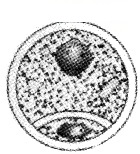
Answer:
It is the structure of pollen grain, it has an outer hard layer called exine that possess prominent apertures called germ pores through which pollen tube come out.
The inner wall layer is continuous called intine. Pollen grain has two cells, a large vegetative cell, and a small generative cell.
Question 17.
Observe the diagram given below.

a) Copy the diagram, and label antipodals and synergids.
b) Explain double fertilization.
Answer:
1.

2. At first, one of the male gametes fuses with egg cell to form a diploid zygote. This is called syngamy. The other male gamete fuses with the polar nuclei to form primary endosperm nucleus (PEN). This is called triple fusion. Thus, two types of fusion occur in the embryo sac called Double fertilization.
Plus Two Botany Sexual Reproduction in Flowering Plants NCERT Questions and Answers
Question 1.
Differences between microsporogenesis and megasporogenesis. Which type of cell division occurs during this events? Name the structures formed at the end of these two events.
Answer:
| Microsporogenesis | Megasorogenesis |
| 1. It is process of formation of microspores from microspore mother cell. 2. It occurs inside the pollen sacs of anthers. | 1. It is the process of formation of megaspores from megaspore mother cell. 2. It occurs in nucellus part of ovule. |
- In both, the events meiosis cell division occurs.
- Microsporogenesis results in the formation of microspores while megasporogenesis forms megaspores.
Question 2.
Arrange the following terms in the correct development sequence: Pollen grain, sporogenous, microspore tetrad, pollen mother cell, male gametes.
Answer:
Sporogenous tissue ’!Pollen mother cell’!Microspore tetrad’!Pollen grain’!Male garnets.
Question 3.
What is meant by monosporic development of female gametophyte?
Answer:
The formation of female gametophyte or embryo sac from a single functional megaspore is called monosporic. The nucleus of functional megaspore undergoes 3 successive mitotic divisions to form haploid nuclei.
Question 4.
With a neat diagram explain the 7-celled, 8-nucleate nature of the female gametophyte.
Answer:
Embryo sac is an oval multicellular structure which contains 8 nuclei but 7 cells.
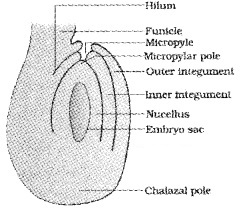
Question 5.
What are chasmogamous flowers? Can cross¬pollination occur in cleistogamous flowers? Give reasons for your answer.
Answer:
Chasmogamous flowers have exposed anthers and stigma. Cross-pollination cannot occur in cleistogamous flowers, as such flowers do not open at all.
Question 6.
Mention two strategies evolved to prevent self-pollination in flowers.
Answer:
Flowering plants have developed many devices to discourage self-pollination and to encourage cross-pollination.
Plus Two Botany Sexual Reproduction in Flowering Plants Multiple Choice Questions and Answers
Question 1.
Apomictic embryos in Citrus arise from
(a) synergids
(b) maternalsporophytic tissue in ovule
(c) antipodal cells
(d) diploid egg
Answer:
(b) maternalsporophytic tissue in ovule
Question 2.
Wind pollinated flowers are
(a) small, brightly coloured, producing large number of pollen grains
(b) small, producing large number of dry pollen grains
(c) large producing abundant nectar and pollen
(d) small, producing nectar and dry pollen
Answer:
(b) small, producing large number of dry pollen grains
Question 3.
Which of the following statements about sporopollenin is false?
(a) Exine is made up of sporopollenin
(b) Sporopollenin is one of the resistant organic materials
(c) Exine has apertures called germ pores where sporopollenin is present
(d) sporopollenin can withstand high temperatures and strong acids
(e) No enzyme that degradessporopollenin is so far known
Answer:
(c) Exine has apertures called germ pores where sporopollenin is present
Question 4.
Egg apparatus of angiosperms consist of
(a) one synergid and two egg cells
(b) two synergid and one egg cells
(c) one central cell, two synergid, and three antipodal cells
(d) one egg cell, two polar nuclei, and three antipodal cells
Answer:
(b) two synergid and one egg cells
Question 5.
In some organisms, karyokinesis is not followed by cytokinesis as a result of which, multinucleate condition arises leading to the formation of syncytium. The perfect example for this is
(a) appearance of a furrow in cell membrane
(b) liquid endosperm in coconut
(c) sexual reproduction
(d) fertilization
Answer:
(b) liquid endosperm in coconut
Question 6.
During the formation of embryo sac, the functional megaspore undergoes
(a) two mitotic divisions
(b) two meiotic division
(c) three meiotic division
(d) three mitotic divisions
Answer:
(d) three mitotic divisions
Question 7.
One advantage of cleistogamy is
(a) it leads to greater genetic diversity
(b) seed dispersal is more efficient and widespread
(c) seed set is not dependent on pollinators
(d) each visit of a pollinator results in transfer of hundreds of pollen grains
Answer:
(c) seed set is not dependent on pollinators
Question 8.
Which one of the following statements is not true?
(a) Pollen grains are released from anthers at 2- celled state
(b) Sporogenous cell directly behaves as he megaspore mother cell
(c) Megaspore divides twice to form an eight nucleate embryo sac
(d) Egg and synergids always lie near the micropylar end of ovule
Answer:
(c) Megaspore divides twice to form an eight nucleate embryo sac
Question 9.
Sporopollenin is chemically
(a) homopolysaccharide
(b) fatty substance
(c) protein
(d) heteropolysaccharide
Answer:
(d) heteropolysaccharide
Question 10.
Which one of the following pairs of plant structures has haploid number of chromosomes?
(a) Megaspore mother cell and antipodal cells
(b) Egg cell and antipodal cells
(c) Nucellus and antipodal cells
(d) Egg nucleus and secondary nucleus
Answer:
(b) Egg cell and antipodal cells
Question 11.
What does the filiform apparatus do at the entrance into ovule?
(a) It helps in the entry of pollen tube into a synergid
(b) It prevents entry of more than one pollen tube into the embryo sac
(c) It brings about opening of the pollen tube
(d) It guides pollen tube from a synergid to egg
Answer:
(a) It helps in the entry of pollen tube into a synergid
Question 12.
Which of the following plant products is the hardest?
(a) Lignin
(b) Cutin
(c) Suberin
(d) Sporopollenin
Answer:
(d) Sporopollenin
Question 13.
A typical angiosperm embryo sac at maturity, is
(a) 4 – nucleate – 2 celled
(b) 8 – nucleate – 7 celled
(c) 4- nucleate – 4 celled
(d) 8 – nucleate – 2 celled
Answer:
(b) 8 – nucleate – 7 celled
Question 14.
Why sometimes, even diploid offspring is produced through parthenogenesis?
(a) When offspring is produced without fertilization of diploid egg cell
(b) When offspring is produced through fertilization of diploid egg cell
(c) When offspring is produced without fertilization of haploid egg cell
(d) When offspring is produced through fertilization of haploid egg cell
Answer:
(a) When offspring is produced without fertilization of diploid egg cell
Question 15.
Pollen grains are stored for long period without losing its viability in
(a) liquid nitrogen
(b) liquidsulphur
(c) liquidsulphur at-1960c
(d) liquidsulphur at-196.50c
Answer:
(a) liquid nitrogen
Question 16.
Filiform apparatus of an embryosac is located at
(a) wall of embryosac
(b) chalazal region
(c) micropylar region
(d) middle of polar nuclei
(e) none of the above
Answer:
(c) micropylar region
Question 17.
Double fertilization is very common in
(a) angiosperm
(b) gymnosperm
(c) pteridophytes
(d) bryophytes
Answer:
(a) angiosperm
Question 18.
In Citms and mango the polyembryony is the special feature of occurance of
(a) more than one embryo
(b) more than one zygote
(c) more than one embyosac
(d) all the above
Answer:
(d) all the above
Question 19.
Triple fusion takes place in angiosperm is due to
(a) fusion of three polar nuclei
(b) fusion of synergid and polar nuclei
(c) fusion of three haploid nuclei
(d) fusion of gametes
Answer:
(c) fusion of three haploid nuclei
Question 20.
In 40 percent of angiosperms, pollen grains are shed at
(a) 2-celled
(b) 3-celled
(c) 4-celled
(d) 5- celled
Answer:
(b) 3-celled
Question 21.
In artificial hybridization, bagging is done to
(a) avoid wanted pollen
(b) avoid unwanted pollen
(c) prevent the entry of unwanted pollinators
(d) allow the self-pollination
Answer:
(b) avoid unwanted pollen
Question 22.
How many mitotic divisions are required for the formation of mature embryosac
(a) 4
(b) 3
(c) 5
(d) 2
Answer:
(b) 3
Question 23.
The allergies and bronchial afflictions in some people often leading to chronic respiratory disorders. It is due to
(a) pollen of parthenium
(b) pollen of hibiscus
(c) pollen of Acasia
(d) both a and c
Answer:
(d) both a and c
We hope the Kerala Plus Two Botany Chapter Wise Questions and Answers Chapter 2 Sexual Reproduction in Flowering Plants help you. If you have any query regarding the Kerala Plus Two Botany Chapter Wise Questions and Answers Chapter 2 Sexual Reproduction in Flowering Plants, drop a comment below and we will get back to you at the earliest.
